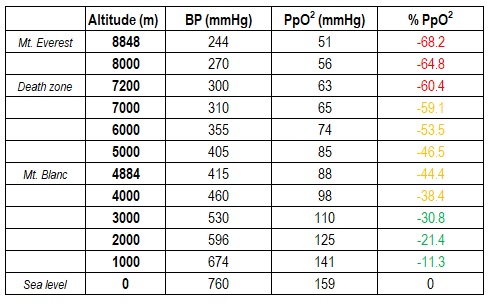Table of Content:
I. Introduction
II. Gas Exchange Efficiency
III. Cardiac and Ventilatory Output
IV. Intensity Thresholds
V. Altitude Adaptations
VI. Conclusion
VII. FAQs
I. Introduction
As an expert enthusiast and advisor in the sports and health-fitness niche, I am excited to delve into the benefits of altitude for training and health. Altitude exposure and physical activity in such environments have gained popularity, with many believing that it can enhance performance. In this article, we will explore the advantages of utilizing altitude for training, its impact on performance, and its benefits for overall health.
Altitude training involves exercising or residing in high-altitude environments, where oxygen levels are lower compared to sea level. Despite the challenges posed by decreased oxygen availability, training at altitude has been found to offer several benefits. Let’s explore these advantages in detail.
II. Gas Exchange Efficiency
Altitude presents a unique challenge to our bodies in terms of gas exchange. While the distribution of gases in the atmosphere remains relatively consistent, the barometric pressure and oxygen partial pressure decrease with increasing altitude. This reduction in oxygen availability challenges the function of our respiratory system and triggers a cascade of physiological adaptations to maintain normal function.

Chart. PpO2 percentage decrease by altitude
III. Cardiac and Ventilatory Output
In response to the reduced oxygen availability at altitude, our cardiovascular and respiratory systems undergo acute adaptations. The body attempts to compensate for the lack of oxygen by increasing ventilation, heart rate, and blood flow. These adjustments aim to meet the demand induced by altitude and exercise, but they do not necessarily enhance efficiency. It is only with continued exposure and physiological adaptations that these systems become more efficient.
IV. Intensity Thresholds
Altitude environments and the accompanying physiological adaptations lead to a metabolic shift. In hypoxic conditions, there is a shift in energy metabolism and a lowering of intensity thresholds. This shift allows us to stimulate higher pathways and biological processes with relative ease, pushing our bodies to new limits. As we ascend to higher altitudes and exercise with increased intensity, we come closer to our physiological limits, maximizing aerobic potential and incorporating a higher degree of anaerobic participation.
V. Altitude Adaptations
Exposure to altitude offers a range of adaptations that can benefit both athletic performance and overall health. Some of the key adaptations include:
- Improved Aerobic Metabolism: Altitude training enhances energy efficiency and dynamism in aerobic metabolism, improving endurance and stamina.
- Enhanced Cardiovascular System Mechanics: The cardiovascular system undergoes positive adaptations, such as increased capillarization and improved cardiac output, promoting better oxygen delivery to muscles.
- Improved Blood Profiles: Altitude exposure can lead to favorable changes in blood composition, such as increased red blood cell production and improved oxygen-carrying capacity.
- Enhanced Anaerobic Metabolism: Altitude training can improve anaerobic performance, enhancing the body’s ability to generate energy during high-intensity bursts.
- Improved Hormonal Response and Sensitivity: Altitude exposure stimulates hormonal responses that can enhance physiological adaptations and improve overall performance.
- Improved Function and Physiological Performance: The combination of adaptations induced by altitude training leads to improved overall function and enhanced physiological performance.
VI. Progression
Altitude serves as a valuable tool for developing adaptations and achieving specific athletic or health-related goals. There are various altitude training strategies, such as “Train low-live high” and “Train high-live low.” These strategies aim to optimize the benefits of altitude exposure. Additionally, acclimatization, which involves temporary exposure to altitude and subsequent return to lower altitudes, plays a vital role in achieving desired adaptations within specific time windows aligned with hormonal and biological rhythms.
VII. Conclusion
Altitude training offers several advantages for athletes and individuals seeking to improve their overall health and fitness. From improved gas exchange efficiency and enhanced cardiovascular and respiratory function to the ability to push intensity thresholds and trigger specific adaptations, altitude training can unlock new levels of performance. However, it’s important to approach altitude training with caution and seek guidance from professionals experienced in this field.
If you’re looking to optimize your training and tap into the benefits of altitude, consider incorporating personalized strength and conditioning programs. These programs, such as the ones offered by ATHL, provide comprehensive training plans that combine functional fitness workouts with an emphasis on strength and conditioning. By tailoring your training to specific goals and utilizing altitude training strategies, you can enhance sports readiness and overall performance.
VIII. FAQs
Q1: Can altitude training benefit non-athletes or individuals with health goals?
A1: Absolutely! Altitude training is not limited to professional athletes. The physiological adaptations induced by altitude exposure can benefit individuals pursuing various health and fitness goals, including improving cardiovascular health, increasing endurance, and enhancing overall fitness levels.
Q2: Is altitude training suitable for beginners?
A2: Altitude training can be adapted to suit individuals of different fitness levels. However, beginners should approach altitude training gradually and under professional guidance. It’s important to acclimatize to the altitude gradually and progressively increase training intensity to avoid overexertion or potential health risks.
Q3: Can altitude training improve sports performance at sea level?
A3: Yes, altitude training can have a positive impact on sports performance at sea level. The adaptations gained from training at altitude, such as enhanced oxygen utilization, increased red blood cell production, and improved cardiovascular function, can translate into improved performance in oxygen-rich environments.
Q4: How long does it take to see the benefits of altitude training?
A4: The timeline for experiencing the benefits of altitude training varies from individual to individual. Generally, significant adaptations can be observed within a few weeks to a couple of months of consistent altitude exposure and training. However, the duration and intensity of training, as well as individual factors, will influence the rate of adaptation.
Q5: Is altitude training suitable for everyone?
A5: Altitude training is a specialized approach that requires careful consideration and guidance. Individuals with certain medical conditions or compromised cardiovascular health should consult with a healthcare professional before engaging in altitude training. It’s important to prioritize safety and well-being throughout the training process.






